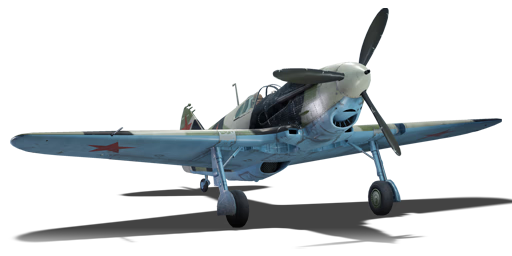

Aviation
LaGG-3-4
II
Rank
AB
2.3
RB
2.3
SB
2.0
Battle rating
USSR
Research country
Fighter
Main role

Premium vehicle
Status
General information
The LaGG-3-4 is a premium gift Soviet fighter. It has been in the game since the start of the Open Beta Test prior to Update 1.27.
The LaGG-3-4 can be flown in one main role: as a fighter. It could potentially be used as a bomber hunter, but it is not feasible for this role due to its average rate of climb and fragile engine.
The LaGG-3-4 is one of the rarest vehicles in-game, only being given to developers and people who have contributed to the game in a significant manner. The LaGG-3-4 is part of the second group of LaGG-3s which include in-game the LaGG-3-8, LaGG-3-11, and LaGG-3-23. All of these planes used the M-105PA engine and had small improvements between then, however, the general playstyle between these aircraft remains the same.
Camouflages
Flight performance
Max speed
at 3,300 m
566529589546 km/h
Rate of Climb
13.811.616.511.6 m/s
Turn time
2122.420.221.8 s
Max altitude
9,500 m
Takeoff Run
403 m
Landing
flaps
flaps
Take-off
flaps
flaps
Combat
flaps
flaps
Air
brake
brake
General characteristics
Crew
1 person
Engine
Length
8.8 m
Wingspan
9.8 m
Wing Loading
188 kg/m²
Weight:
Base weight
2.96 t
Fuel in main tanks
0.35 t (1h 13m)
Limits:
Max Speed Limit (IAS)
700 km/h
Mach Number Limit
0.8 M
G limit
≈ -8/11 G
Flap Speed Limit (IAS)
L / T / C
280 / 414 / 440 km/h
Gear Speed Limit (IAS)
350 km/h
Offensive armament
20 mm ShVAK cannon
Ammunition
160 rounds
Fire rate
800 shots/min
One-second Burst Mass
1.29 kg
| Belt | Belt filling | Armor penetration (mm) at a distance: | |||||
|---|---|---|---|---|---|---|---|
| 10 m | 100 m | 500 m | 1000 m | 1500 m | 2000 m | ||
| FI-T/AP-I | 28 | 24 | 14 | 7 | 4 | 2 | |
| FI-T/HEF/AP-I/FI-T | 28 | 24 | 14 | 7 | 4 | 2 | |
| HEF/FI-T/AP-I | 28 | 24 | 14 | 7 | 4 | 2 | |
| FI-T | 4 | 4 | 4 | 4 | 4 | 4 | |
| AP-I/FI-T/AP-I/AP-I | 28 | 24 | 14 | 7 | 4 | 2 | |
| AP-I/HEF/HEF/FI | 28 | 24 | 14 | 7 | 4 | 2 | |
12.7 mm Berezin UBS machine gun
Ammunition
200 rounds
Fire rate
996 shots/min
One-second Burst Mass
0.79 kg
| Belt | Belt filling | Armor penetration (mm) at a distance: | |||||
|---|---|---|---|---|---|---|---|
| 10 m | 100 m | 500 m | 1000 m | 1500 m | 2000 m | ||
| T/AP/AP/IAI | 32 | 30 | 22 | 15 | 11 | 7 | |
| AP-I/API-T/IAI/IAI | 29 | 27 | 20 | 13 | 9 | 6 | |
| API-T/AP-I/AP-I/IAI | 29 | 27 | 20 | 13 | 9 | 6 | |
| AP-I(c)/AP-I/AP-I/API-T/IAI | 34 | 32 | 24 | 17 | 12 | 8 | |
| API-T | 29 | 27 | 20 | 13 | 9 | 6 | |
| AP-I/AP-I/IAI | 29 | 27 | 20 | 14 | 9 | 6 | |
2 × 7.62 mm ShKAS machine gun
Ammunition
1,300 rounds
Fire rate
1,800 shots/min
One-second Burst Mass
0.29 kg
| Belt | Belt filling | Armor penetration (mm) at a distance: | |||||
|---|---|---|---|---|---|---|---|
| 10 m | 100 m | 500 m | 1000 m | 1500 m | 2000 m | ||
| T/Ball/Ball/AP-I/AI | 13 | 12 | 7 | 3 | 2 | 0 | |
| AP-I/AI/API-T | 13 | 12 | 7 | 3 | 2 | 0 | |
| AP-I/API-T | 13 | 12 | 7 | 3 | 2 | 0 | |
| AP-I/AP-I/AP-I/AI | 13 | 12 | 7 | 3 | 2 | 0 | |
Economy
Repair cost
AB
548 

RB
1,140 

SB
547 

Crew training
2,300 

Experts
15,000 

Aces
125 

Research Aces
320,000 

Reward multiplier
AB / RB / SB
 2 x (30 / 75 / 125) %
2 x (30 / 75 / 125) % 
 2 x 112 %
2 x 112 % 

Premium vehicle
All modifications are unlocked
Flight performance | |
|---|---|
Weaponry | |
|---|---|
Rating by players
You must play more than 3 battles for the last week and more than 10 battles in a vehicle to rate it.
Like:
17
Flight performance:
Not enough ratings
Survivability:
Not enough ratings
Aerial combat:
Not enough ratings
Ground attack:
Not enough ratings
Balance:
Not enough ratings
Tips & Tricks
This space is currently empty
Do you know any interesting vehicle features?
Loading...
No articles about this vehicle yet
Become the first author and get rewards!
Write a guide, tell about interesting historical facts, make a tutorial or simply an interesting post.
No more content